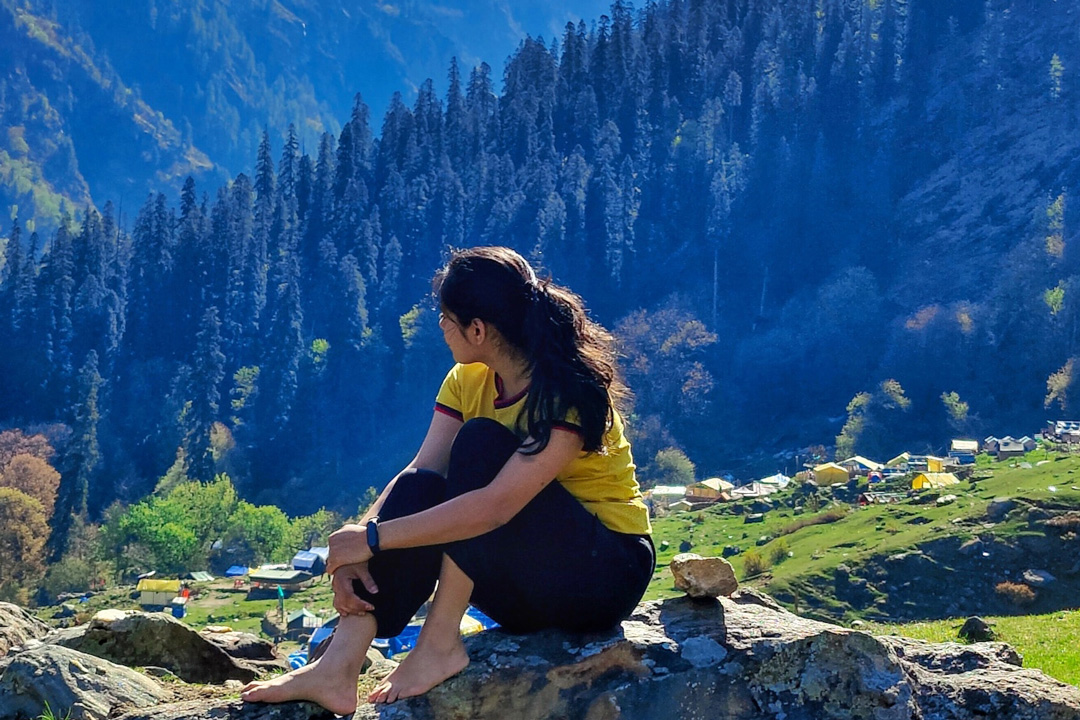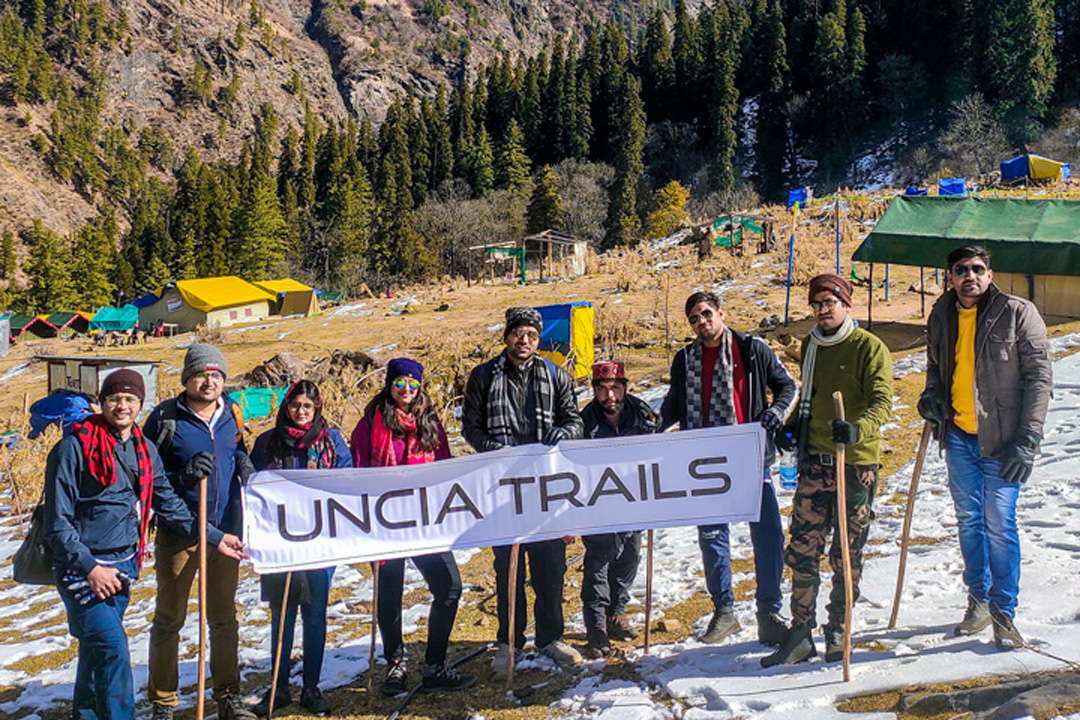2 Days 1 Night
Daily Tour
100 people
___

Morning 10:00 am
The guide will pick you up from Barshani. After a short briefing, you will start your trek towards Kheerganga via Rudranaag or Kalga. After climbing for 12 km, you will reach Keerganga in the evening and check in to your campsite.
Meals: Dinner
Night: Stay at the Camps

Morning 10:00 am
Wake up with a view of Parvati Valley. After having your breakfast, prepare for the journey back to Barshaini. After descending, you can board a bus or cab to Kasol at your own expense.
Meals: Breakfast
Night: Nil
| Location | Local Sightseeing |
| Kheerganga | Kalga, Rudranaag, Kheerganga Waterfall, Parvati River, Parvati Dam |
Note: Sometimes, we may shift your stay from Kheerganga top to Rudranaag due to heavy snowfall or restrictions by the forest department
We understand that plans can change, but the booking amount is non-refundable due to the costs we incur in preparing for your tour or activity. If you wish to reschedule for a different date, we'll adjust it to the same package, providing you with the necessary flexibility. If you have paid the total amount but cancelled the package. You will be provided with a refund, as mentioned below:
Tours or activities may be cancelled due to unforeseen events beyond our control, weather conditions such as heavy rain or storms, or government restrictions like sudden closures of specific areas. In such a scenario, we will provide an alternate tour or activity. However, no refunds will be provided.
Kheerganga is located in the Kullu district of Himachal Pradesh, India. Situated about 22 km from Manikaran, reaching Kheerganga involves a trek through dense forests, culminating in a relaxing bath in natural hot springs. The journey from Barshaini, the last motorable point, to Kheerganga typically takes around four hours on foot. During this trek, you’ll pass through picturesque villages and scenic spots like the Rudra-Nag waterfall, a serpent-shaped cascade. After crossing a bridge over the Parvati River, the trail becomes steeper, eventually leading to the Kheerganga slope, where you’ll find food tents and a temple devoted to Lord Shiva and Goddess Parvati. This temple is also located in the famed hot spring, known for its medicinal properties.
The trek is best avoided during winter months due to snow, which can make the trail treacherous and the rocks slippery. Along the route, a few restaurants offer non-vegetarian dishes, including Indian, Chinese, and Continental cuisines. Near the Shiva temple, an ashram provides basic accommodations with essential amenities.
According to legend, Kartikeya, the younger son of Lord Shiva and Parvati, meditated at Kheerganga for a thousand years, making it a significant religious site for Hindus. The name “Kheerganga” is derived from a mythological story where Parvati, visiting her son, would cook kheer (a rice pudding) in the nearby hot spring, which gave the water its milky appearance. While this story adds a mystical touch, the hot springs maintain a boiling temperature year-round and have a rice-water-like colour.
Kheerganga Mythology
Kheerganga, a renowned trekking destination starting from Kasol, is situated at an altitude of 2970 meters above sea level. Numerous mountain ranges surround this quaint and scenic village. The name “Kheerganga” is derived from its resemblance to Kheer, a traditional Indian dessert made from milk, due to the milky-white appearance of its waters. These waters flow persistently into the Parvati Valley from the surrounding mountains, lending the area its distinctive name.
Kheerganga is steeped in historical and religious importance. It is said that Lord Shiva spent many years meditating in this area, making it a sacred site for both Hindus and Sikhs. The legend further extends to Kartikeya, the brother of Lord Ganesha, who is said to have meditated in Kheerganga after his defeat by Ganesha. Another mythological story involves Parvati, who, while visiting her son, used the natural hot springs in Kheerganga to prepare rice pudding. This event is said to have contributed to the area’s sacred reputation and the name “Kheerganga.”
How was Kheerganga named?
Kheerganga, as the name proposes, is River Ganga, which is as white as Kheer (an Indian sweet dish made from milk and rice). The name Kheerganga as the water flowing in all its vastness appears milky, and its streams flow into Parvati Valley from all sides of the mountain. The valley is so abundant in water resources that a Hydel Power Project is beginning in the village of Barshaini. Kheerganga is undoubtedly a hidden gem and quite offbeat, but its beauty lies in being untouched!
Trekking Routes to Kheerganga Trek
Nakthan Village Route: This route is shorter but more challenging than others. The trek begins with a relatively easy path through apple orchards and deodar forests in the picturesque Nakthan Village. Beyond Nathan, you’ll encounter Rudranag, a charming meadow in Parvati Valley known for the sacred Rudranag Temple, nestled by waterfalls and lush greenery. Despite its difficulty, many trekkers prefer this route for its scenic beauty.
Kalga Village Route: Kalga offers a less steep, rocky trail to Kheerganga. Trekkers can take this route to reach Kheerganga and descend via the Nakthan Village trail to experience its unique environment. Kalga also features numerous homestays and cosy cafés, making it an excellent night spot.
Tosh Village Route: Another option is to stay overnight in Tosh Village and then trek to Kheerganga the next day. This route can be accessed from Barshaini. After passing Rudranag Temple, all three trails converge into one path. During the trek, you can enjoy charming cafés, like the famous Shalom Café.
Things to Do in Kheerganga:
The Kheerganga trek in Himachal Pradesh, India, is renowned for its natural hot springs, breathtaking scenic views, and spiritual significance. It features hot springs that are believed to be linked to the Shiv Parvati story. Hikers can enjoy 360-degree views of the mountains and jungle, with the Kheerganga Temple—dedicated to Lord Shiva—adding to the trek's spiritual allure. Legends say Lord Shiva and his son Kartikeya meditated here, adding to its mystical charm.
The Kheerganga trek in Himachal Pradesh is moderately challenging and suitable for beginners and backpackers. It involves waterfall crossings, steep climbs, and muddy trails through forests. The trek covers 12–24 km round-trip and takes about 4–5 hours to complete. It features hot springs, scenic trails, and valley views.
| Best Time for Kheerganga Trek | Details |
| Ideal Months | April to June, September to November |
| Weather | Pleasant and clear trails |
| Avoid | July and August (monsoon season: heavy rains, landslides, road blockages) |
| Snow Option | December (for snow experience) |
| Best Time of Day | Afternoon (to stay warm and enjoy the scenery) |
To reach Kheerganga, you can choose from three main routes: Nakthan Village Route: Start from Nakthan Village, trek through apple orchards and deodar forests, and pass by the Rudranag Temple. This route is scenic but challenging. Kalga Village Route: Begin at Kalga for a less steep, rocky trail. For a varied experience, descend via the Nakthan Village trail. Kalga offers cozy homestays and cafés. Tosh Village Route: Stay overnight in Tosh Village, then trek to Kheerganga via Barshaini. This route merges with the Nakthan Village trail after Rudranag Temple, and you can enjoy charming cafés.
Near Kheerganga, you'll find various food options, including Chinese, Israeli, Indian, and local Himachali cuisine. The food quality is moderately good and pocket-friendly. Don’t miss trying hot drinks like tea and coffee at the local dhabas and cafés, which are perfect for refreshing with stunning views.
The Kheerganga trek is about 12 kilometres long and is of moderate difficulty. It's suitable for beginners with decent fitness and can typically be completed in 5-6 hours, including breaks.
For the Kheerganga trek, follow these safety measures and precautions: Physical Fitness: Make sure you are in good physical shape and seek medical advice if you have any pre-existing health issues. Trekking Gear: Carry essential gear like a quality backpack, trekking shoes, headlamp/torch, water bottle, first aid kit, and sleeping bag. Hydration: Hydrate yourself by drinking water and using purifying tablets or a water filter. Wildlife Safety: Avoid feeding wildlife and secure your food to prevent encounters. Environmental Conservation: Respect the environment by not littering and disposing of trash properly.
Mobile networks do work in Barshaini, Kalga, and Tosh. Kheerganga may have BSNL connectivity, but making essential calls before beginning the trek is better. There are no ATMs close to Kheerganga, so take adequate money. There is a solitary ATM in Kasol and two or three ATMs in Manikaran, but they are often cashless.
To reach Kheerganga, follow these steps: By Road: Travel by bus from Delhi to Kullu or Manali, then to Bhuntar. From Bhuntar, take a local bus to Kasol. Proceed to Barshaini on your own or in a hired cab. Trek from Barshaini to Kheerganga. By Rail: From Delhi, reach Pathankot or Chandigarh railway station, then use local transport to Kasol. Travel to Barshaini and trek to Kheerganga. By Flight: Fly from Delhi to Bhuntar Airport (near Kullu). From Bhuntar, travel to Kasol or Barshaini by public transport or cab. Trek from Barshaini to Kheerganga.
Leave a review